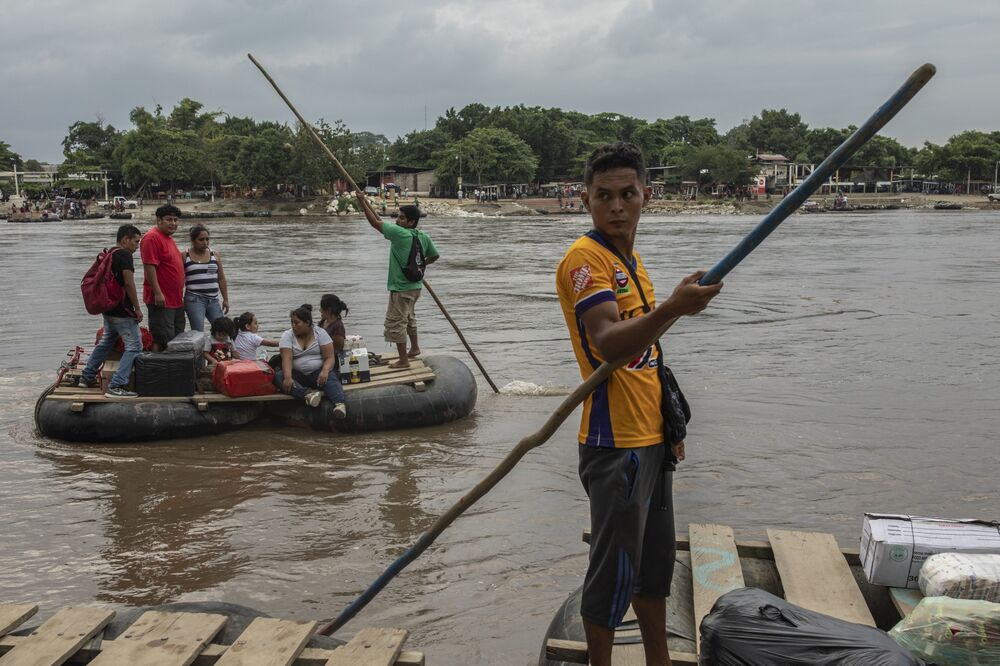
The rafts, made of plywood planks lashed to fat inner tubes, float back and forth all day, piloted by camareros who push poles deep into the riverbed to guide their vessels.
If the rafts are headed toward Guatemala, its cargo is usually cans of cooking oil or bags of rice, cases of Corona and cartons of eggs. But mainly, people are going the other direction, with the U.S. as a hoped-for final destination.
All of it, technically speaking, is illegal, but the customs and immigration officials on the international bridge never paid much mind, allowing the Suchiate River crossings to build into the cornerstone of a thriving economy in an impoverished region.

That ended, at least for now, with last week’s arrival of a few thousand troops sent by Mexican President Andres Manuel Lopez Obrador.
“The soldiers came with their M-16s and told us that they didn’t want us to work,” said a 31-year-old in Ciudad Hidalgo, who goes by the nickname Rooster.
The new show of force on the border is meant to stem the stream of migrants from Central America and appease U.S. President Donald Trump after he threatened to impose tariffs on Mexican imports.

But the ripple effects could be devastating in Chiapas, the poorest state in Mexico, and in the administrative district of San Marcos in southwestern Guatemala, where almost two-thirds of people live in poverty. A network of suppliers and couriers pedaling tricked-out tricycles on the Mexican side keeps the camareros stocked with products that are either unavailable or prohibitively expensive in Guatemala — Ace detergent, Nivea skin cream, Nescafe instant coffee, mayonnaise, PediaSure nutrition drinks, toilet paper, McCormick spices and on and on. Rafts have been known to ferry washing machines across.

“This industry maintains the tricycles, the raft operators, the taxis, buses, everyone lives off of this. What happens if it’s gone?” said Bertha Alicia Fuentes, 71, who has been running a supply store in Ciudad Hidalgo for four decades, selling mostly yogurt and milk for river-export to Guatemala. “Forget it. Everyone would be poor.” She shook her head and lifted her hands in exasperation. “The merchandise needs to continue to flow.”
While the river trade has existed for generations, it exploded over the past five years as the Mexican peso lost one third of its value against the Guatemalan quetzal. There are no official statistics on the value of the commerce, but according to locals it’s the biggest, and almost only, business around.

AMLO has acknowledged that there are 68 points on Mexico’s 700-mile frontier with Guatemala and Belize that aren’t well policed and has promised to secure them. Maximiliano Reyes, undersecretary of foreign relations for Latin America and the Caribbean, said on a recent trip to the area that the Suchiate rafts “are one of the primary points of irregular immigration” and that they are “something we’ll need to be looking at.” Francisco Garduno, the new head of the national migration agency, went further and said the raft traffic would be stopped.
Rooster, who declined to give his name for fear of reprisal, said he understands what the president and troops are up against. “The soldiers are workers, just like us, and they need to do their duty,” he said, leaning against a crate of beer in the shade of a tarp. And “AMLO did what he had to do,” under pressure from Trump.
What the policy makers in Mexico City might not comprehend, though, is what a diligently patrolled border with Guatemala would really mean, Rooster said. “This town and Tapachula would be bankrupt. The majority of the people who buy here are Guatemalans.”









